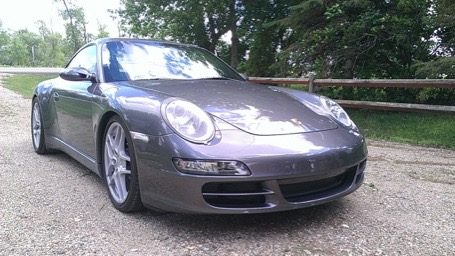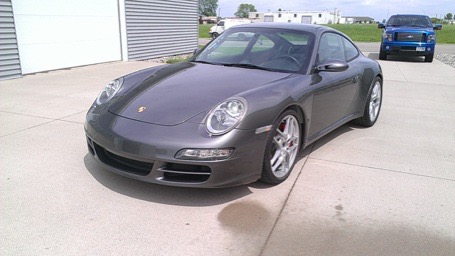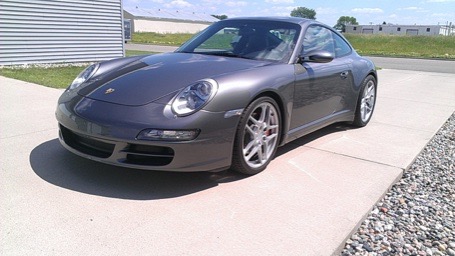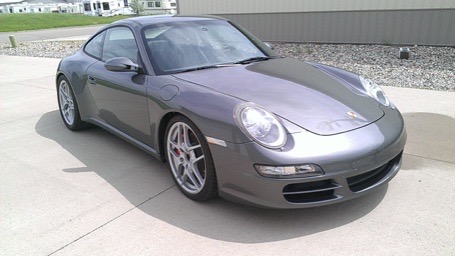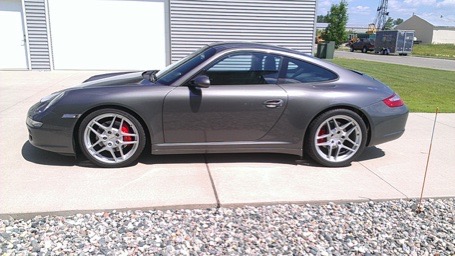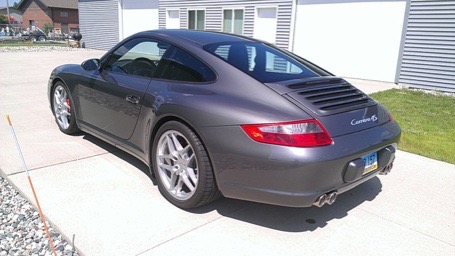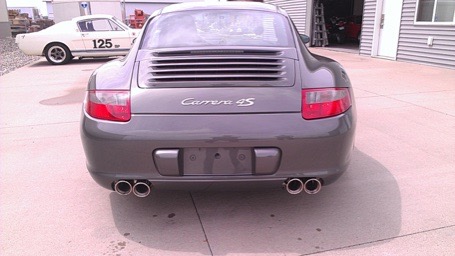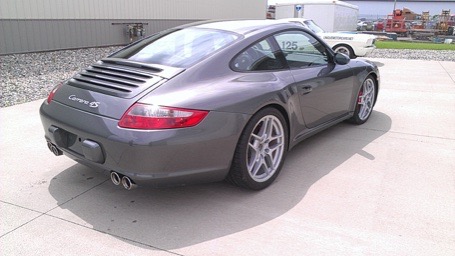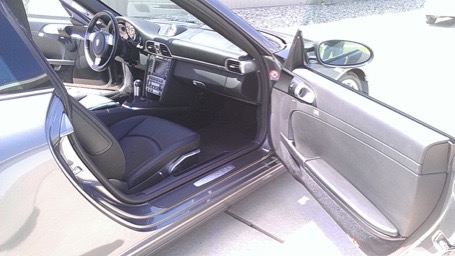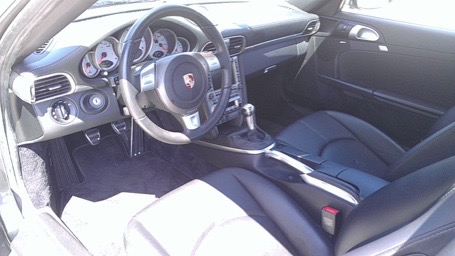2007 Porsche 911 C4S, Metor Gray, black interior, slick roof, sport buckets, 6 speed, Bose sound system with rear factory subwoofer, carbon fiber air box, bilstein pss10 coil overs.
Comparison of C4 vs C4S
The width of the car shows the difference: The most striking, eye-catching highlight of the 911 Carrera 4 and 911 Carrera 4S are the wheel arches flared out on each side by 22 millimetres or 0.87”, accommodating 295/35 ZR 18 tyres on the 911 Carrera 4 and 305/30 ZR 19 tyres on the 4S. A feature shared by both models is their four-wheel drive conveying power to the road with absolute superiority and in perfect style: 239 kW (325 bhp) in the case of the 3.6-litre 911 Carrera 4 and an even more impressive 261 kW (355 bhp) on the 911 Carrera 4S. On the road, this means acceleration from 0 – 100 km/h in the Carrera 4 in a mere 5.1 seconds, with top speed of 280 km/h or 174 mph. The S-model is another 8 km/h or 5 mph faster, accelerating to 100 km/h in 4.8 seconds.
Performance
The new 911 Carrera 4 engine is a six-cylinder unit displacing 3.6 liters and developing 325 hp at 6,800 rpm. Maximum torque of 273,8 pound feet is available from as low as 4,250 rpm. The engine can propel the 911 Carrera 4 from 0 to 60 mph in 4.9 seconds.
The new 911 Carrera 4S model is armed with a larger 3.8-liter displacement engine offering 355 horsepower at 6,600 rpm. Maximum torque is 295 pound-feet at 4,600 rpm. The impressive output is capable of propelling the Carrera 4S from 0-to-60 mph in 4.6 seconds and to a top track speed of 179 mph (manual transmission model).
Four-wheel drive for even greater dynamic performance
Four-wheel drive with a viscous multiple-plate coupling conveys a minimum of 5 per cent of the engine’s power to the front wheels, increasing the transmission of power to the front to a maximum of 40 per cent where required. Clearly, this benefits in particular the car’s driving stability in bends as well as directional stability at very high speeds, not to mention traction on difficult, rough terrain.
ENGINE AND TRANSMISION
The Porsche six-cylinder ‘boxer’ engine is a definitive element within the 911 concept. Flat and compact, with a low center of gravity, its rear-mounted installation has generated optimum traction throughout more than four decades of continuous evolution. In today’s generation, its immediacy and sound are more inspirational than ever.
The PorscheCarrera 4 models are powered by engines already well-known in the market: The 3.6-litre six-cylinder in the 911 Carrera 4 develops maximum output of 239 kW (325 bhp), the 3.8-litre in the 911 Carrera 4S delivers an even more significant 261 kW (355 bhp). This kind of power accelerates the 911 Carrera 4 to 100 km/h in 5.1 seconds, giving the car a top speed of 280 km/h or 174 mph. Accelerating from 0 – 100 km/h in just 4.8 seconds and reaching a top speed of 288 km/h or 179 mph, the 911 Carrera 4S is an even more outstanding performer.
Add to this the Carrera 4´s intelligent all-wheel drive and the result is laser-true tracking at speed and unprecedented tracking through the tightest corners.
Alloy engine
In engineering, one rarely gets something for nothing. Every advance invariably involves an offsetting challenge. It’s how these issues are addressed that ultimately defines the true talents and capabilities of the engineering team.

Take an all-alloy engine for example. The advantage is obvious: it weighs less than a conventional cast iron engine thereby improving the car’s relative performance and handling. However, an all-alloy engine is more susceptible to temperature changes, which can shorten component life such as the engine bearings.
To address this issue, the main bearing bracket is made from aluminum alloy with special cast-in iron support elements. These iron elements hold the bearings and minimize bearing play caused by changes in engine temperature. This approach also allowed Porsche engineers to reduce the bearing clearances, which greatly reduce engine noise. A further advantage of smaller bearing clearances is a reduction in the amount of oil required. Since less oil is needed, the oil pumps can be smaller enhancing overall engine efficiency. Clearly, Porsche engineers have succeeded in developing an elegant solution that fully optimized the advantages of the all-alloy engine.
VarioCam Plus
VarioCam Plus is a remarkably innovative system that continually adjusts the valve timing for optimum performance at all times. Key benefits include increased power and torque at all engine speeds as well as smoother running, better fuel economy and fewer exhaust emissions.

VarioCam Plus combines variable valve timing with two-stage lift on the intake side. The two-stage valve lift function is performed by electro-hydraulically operated switchable tappets. Each of these 12 tappets consists of concentric lifters, which can be locked together by means of a pin. The inner lifter is actuated by a small cam lobe, while the outer ring element is moved by a pair of larger-profile lobes. The timing of each valve is seamlessly adjusted by means of an electro-hydraulically operated rotary vane adjuster located at the head of each intake camshaft.
The valve timing and valve profile are continuously changed according to conditions and engine load. For example, for cold starting and initial responsiveness, VarioCam Plus raises the amount of lift and retards the valve timing. At medium revs and minimal load, the valve lift is lowered and timing advanced to help minimize fuel consumption and emissions. While for maximum power and torque, the lift is raised and the timing advanced.
All operations are controlled by a powerful ECU that manages the engine’s operation and makes the appropriate adjustments. On-board diagnostics provide continuous monitoring and early fault detection for the exhaust and fuel supply systems. This results in active prevention of harmful emissions as well as consistent fuel consumption.
Engine Management
Optimal engine performance is readily available instantly thanks in large part to the new Motronic ME 7.8 engine management system. This highly precise system monitors and controls all engine related functions including valve timing, fuel injection and ignition timing. It also controls the electronic throttle, one of the key elements for Porsche Stability Management (PSM).

One of the most important tasks performed by the engine management system is cylinder-specific knock control. By preventing pre-ignition at high engine speeds, this function can avert costly damage to the pistons and cylinders. Since temperatures tend to vary in different parts of the engine, each cylinder is monitored separately. If a risk is detected, the engine management system will adjust the ignition timing on the respective cylinder.
Fuel is supplied to each of the six cylinders by means of sequential fuel injection. The timing and volume of each injection are controlled by the engine management system. Adjustments are based on a range of variables such as throttle position, engine speed, coolant temperature and exhaust gas composition. A hot-film air mass sensor monitors the density of the air/fuel mixture to ensure the most complete combustion, regardless of weather and altitude. This in turn delivers excellent fuel economy in an automobile capable of exhilarating levels of performance. Another important benefit of reliable combustion is the car’s absolute compliance with all relevant exhaust emission standards.
The static high-voltage ignition system uses a separate ignition coil on each individual spark plug. The role of the distributor is performed by the engine management system, which can modify the ignition timing as required. A major benefit of this arrangement is that the ignition can be integrated with all other electronically managed systems and components. If the Tiptronic S transmission’s control unit, for example, requests smoother downshifts, the engine management system will modify the ignition timing accordingly.
Braking even faster with enhanced Porsche Stability Management
Featured as standard on the four-wheel-drive models, Porsche Stability Management (PSM) comes with two functions optimising brake behaviour to an even higher level: Pre-filling of the brake system moves the brake pads to the immediate vicinity of the discs prior to fast, hard application of the brakes. The result is an even more spontaneous build-up of brake power for even shorter stopping distances.
The second function is activated whenever the driver needs the full power of the brakes: Should the driver press down the brake pedal quickly but not with full force, the hydraulic brake assistance pump builds up the additional pressure required and increases brake power on all wheels to the ABS control mode for optimum safety and minimum stopping distances.
Two cars – two suspensions
As opposed to the conventional chassis and suspension of the Carrera 4, the Carrera 4S comes as standard with an active damper system: Porsche Active Suspension Management (PASM) combines two suspensions in one – a sporting, comfortable suspension for long distances and, at the touch of a button, an extra-sporting and dynamic set-up for the race t rack. This active suspension is also ava ilable as an option on the “basic&quo t; model, with a specially tuned sports suspension coming as an option on both models in the Carrera 4 family.
For the dynamic driver: Sports Chrono Package Plus
The 911 Carrera 4 and Carrera 4S are also available with Porsche’s Sports Chrono Package: Simply by pressing a button, this feature allows the driver to set various control maps and strategies to a particularly sporting style of motoring. And combined with a stop watch, a lap counter, and the evaluation logic required, the complete system gives the driver a truly unique sports program for a thrilling and convincing experience on the race track.
Driving Dynamics Times Four
The Porsche 911 Carrera 4 and Carrera 4S all-wheel-drive coupés further expand the 911 model family. These outstanding models in the range are indeed clearly recognisable at very first sight: The extra-fat rear wheels measuring 295/35 ZR 18 on the Carrera 4 and an even more impressive 305/30 ZR 19 on the Carrera 4S are encased by wheel arches extended far out to each side, widening the rear end of the car by no less than 44 millimetres or 1.73” overall. The sophisticated all-wheel-drive system that transfers power onto the pavement with conviction on new Carrera 4 models has been augmented by enhancements to the Porsche Stability Management (PSM Plus) system. This system lends even higher levels of performance to the 911 models robust braking system. In addition to the litany of handling improvements highlighted on the previous pages, the all-wheel-drive version of PSM offers two additional functions that work in concert with the 911 braking system to shorten stopping distances. Should the driver suddenly release the throttle, PSM Plus automatically increases pressure in the brake lines slightly to eliminate the air gap between pads and discs. If the driver then applies the brakes, the response from each caliper is that much more immediate.

All-wheel drive for extra driving dynamics

What you can only see from outside the driver really feels inside: Benefiting from four-wheel drive permanently conveying anything between 5 and 40 per cent of the engine’s drive power to the front wheels, the two coupés offer supreme balance and roadholding in bends all the way to the utmost limit, absolutely stable directional stability up to their top speed, and an even higher standard of all-round traction also on slippery road surfaces. The central distribution of power in the Carrera 4 and Carrera 4S is provided by the viscous multiple-plate coupling. The front axle final drive, in turn, is fundamentally the same as on the former four-wheel-drive models, now however coming with a modified transmission ratio due to the larger tyres differing in size.
Six-Speed Manual Gearbox
The new six-speed manual gearbox in all new 911 models is designed for optimum performance. Each of the six ratios has been carefully selected to take maximum advantage of the engine’s extraordinary power and torque. The gearbox is driven through a dual-mass flywheel, which helps minimize noise in the drivetrain. Noise is further reduced by the cable-operated gear linkage, which insulates the lever from the engine and gearbox.

The gear lever throw has been shortened by 15% without sacrificing smoothness or precision. This translates into faster, more positive gearshifts requiring minimal effort from the driver. Gear selection is further enhanced by the race-inspired pedal design and placement.
On the 911 Carrera 4S, the gearbox is mated to a high-performance self-adjusting clutch. The result is a substantial reduction in the added release loads, which are normally encountered as the clutch begins to wear.
Bose Sound System
Step up to the new BOSE Surround Sound System, and the sport seats of your new 911 are transformed into front-row seats at the concert of your choosing. Created expressly for the unique acoustics of the 911, it’s a revolutionary technology that offers dramatic sound reproduction regardless of driving conditions.

The BOSE approach to acoustic design is very similar to the design philosophy of a Porsche: engineer each component to the highest standards of performance, then integrate them in such a way that the whole becomes greater than the sum of its parts. Thousands of measurements from every conceivable angle were used to determine the precise placement of each component for countering road, wind and engine noise. A 13-speaker lay-out enhanced by independent front and rear channels serves to create a push-button panorama of sound that duplicates the quality of live music.
The system is powered by a seven-channel digital amplifier and active equalization that matches sound to the acoustics of the 911 interior. A fiber optic network beneath the dashboard integrates 5 x 25-Watt linear amps and a single 100-Watt switching unit with sparkling signal quality, while a second switching amp in the active subwoofer offers an additional 100 Watts of power.
Low-range and mid-range speakers harmonize with Neodym tweeters to flood the cockpit with deep, rich bass and sparkling high-range sounds. The sense of depth is increased further with the aid of BOSE Signal Processing and a Centerpoint™ technology that can split stereo recordings into five separate channels.
BOSE Signal processing modifies bass output to compensate for the reduced sensitivity of the human ear at lower volumes. The result is an amazing clarity of sound with full, rich bass at any volume level and natural voice reproduction. The system can even reach concert hall volumes with no audible noise distortion.
Even at speed, the BOSE system ensures that you never misses a beat. An ingenious AudioPilot™ noise compensation technology continuously monitor the cockpit for ambient noise and automatically adjusts tone and volume levels to filter it out. Like the Porsche 911, it’s wired for the highest levels of performance.
Porsche Active Suspension Management
Porsche Active Suspension Management (PASM) is an electronic control system which uses continuous damper adjustment to maintain optimum ride quality and comfort. The push-button system is standard on the 911 Carrera 4S and optional on the 911 Carrera 4.

PASM has two setup modes, “Normal” and “Sport”, with only minimal overlap between the two. While the former is a mix of performance and comfort, the “Sport” setup mode has a much firmer range of settings for greater performance capabilities. The system responds to changing road conditions and/or driving styles by applying a variable damping force within the defined range for the selected mode (“Normal” or “Sport”).
To do that, PASM uses a series of sensors that monitor all movements of the car’s body. The PASM control unit then evaluates this data and modifies the damping force on each of the wheels. The results are a reduction in pitch and roll as well as consistent road-holding on all four wheels.
If “Sport” mode is selected, the suspension is set to a harder damper rate. If the quality of the road surface drops below a certain threshold, the system immediately changes to a softer rating within the “Sport” setup band and thus restores the car’s grip and traction. When the road surface improves, PASM returns to the original, harder setting.
If “Normal” mode is selected, and the car is driven assertively, PASM automatically switches to a harder rating within the “Normal” setup band. As the dampers become stiffer, the car becomes more stable and responds more quickly to driver inputs.
In either case, the result is a car which can adapt the way it handles and rides to the driver’s driving style.
